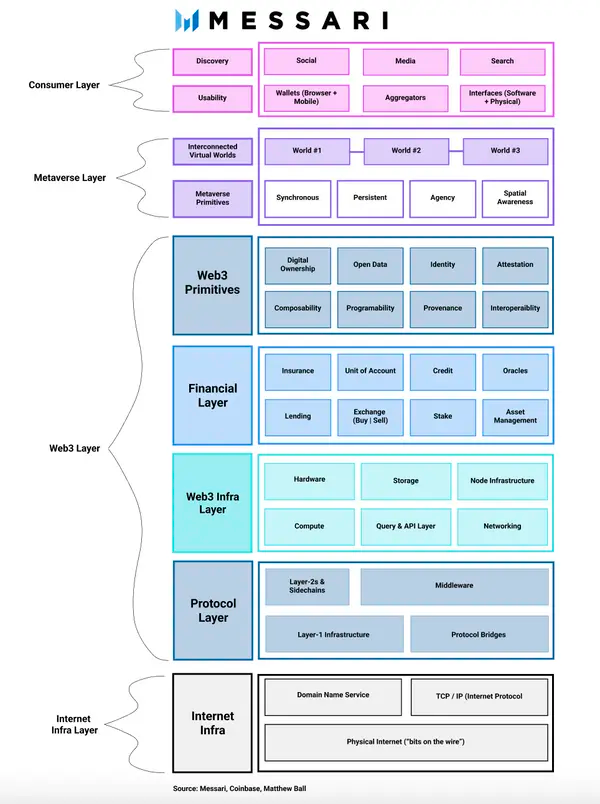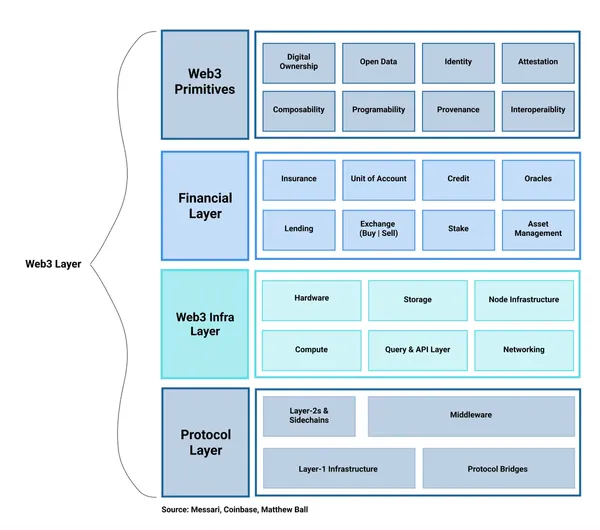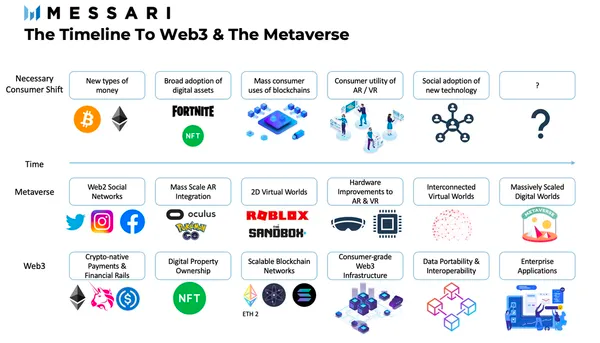Messari: An Analysis of the Role of Web3 in the Metaverse Technology Stack
The Role of Web3 in the Metaverse
Author: Mason Nystrom, Messari Researcher
Translation by: Metaverse Task Force
Some friends have mentioned that they feel the hype around the metaverse is declining recently. Yes, the bubble of frenzied speculation is bursting; however, the exploration and construction of the metaverse, which allows people to work, live, learn, and entertain independently and freely in the digital world, has just begun.
Today, the Metaverse Task Force translates a report from Mesarri Pro report, to see how the author Mason Nystrom introduces the role and function of Web3 in the metaverse with a concise hierarchical stack diagram.

“No one knows what it means, but it’s so exciting that everyone is thrilled.”
Defining the Metaverse
The metaverse remains a term that is not yet fully shaped or clearly defined, although this has not stopped prominent individuals or institutions from trying to do so.
I have gathered various best definitions from companies and individuals at the forefront of this field:
Meta (formerly Facebook): A place where we will play and connect in 3D.
Coinbase: The future of the internet, a massive, persistent, interactive, and interoperable real-time platform made up of interconnected virtual worlds where people can socialize, work, trade, play, and create.
Pier Kicks of Bitkraft Ventures: A persistent, real-time digital universe that gives individuals a sense of agency, social presence, and shared spatial awareness, as well as the ability to participate in a broad virtual economy with far-reaching social implications.
Matthew Ball of Epyllion Ventures: The metaverse is a massive, interoperable, real-time rendered network of 3D virtual worlds that can be synchronously and persistently experienced by an effectively unlimited number of users, with personal presence and continuity of data such as identity, history, rights, objects, communication, and payments.
Just like in the early days of the internet, definitions are largely unimportant, but the overall themes remain meaningful. From these definitions, we can weave a common thread from phrases like “massive digital worlds” and “virtual economy (trading and gaming)” as well as terms like “synchronous,” “connected,” and “interoperable/data portability.”
In the early applications of the internet, it was similarly categorized with phrases like “real-time information,” “information networks,” and “public access.” What the internet ultimately manifested was far more than early definitions suggested, but its fundamental attributes remain true.
Similarly, for the metaverse, its core value will be driven by composable data, rich synchronous (shared) experiences, and greater digital agency in individuals' online lives. We should regard these attributes as guiding lights for the “metaverse,” rather than a definition that will undoubtedly change in the coming years.
The Role of Web3 in the Metaverse Technology Stack
We can imagine the potential interconnected infrastructure of the metaverse and Web3 from the perspective of the end consumer.

Consumer Layer
Users will interact with applications at different levels—typically at the application level or through aggregators and interfaces. Since this chart is stacked from the consumer's perspective, there should be dominant services on how users interact with metaverse applications: discoverability and usability.
The discoverability layer will help consumers find the metaverse, while the usability layer—mobile applications, wallets, and interfaces—will abstract the complexities of interacting with these virtual worlds for a more convenient experience. Clearly, some aggregators or interfaces could potentially provide both functionalities.

Metaverse Layer
While the manifestations of the metaverse have yet to be concluded, viewing the metaverse as an application layer may be the simplest approach. The metaverse layer is where users find virtual worlds, whether they are 2D worlds, virtual worlds (3D), or augmented reality in the real world.
The existence of these worlds is based on the fundamental elements of the metaverse identified in our early definitions. For example, the metaverse should be synchronous—occurring at the same time. But now, even the most high-profile virtual experiences, such as the “Fortnite” concert—which attracted millions of viewers—are not unified experiences.
Instead, virtual concerts are fragmented into thousands of experiential spaces, with each experience (concert) hosting a maximum of 50-100 players. Additionally, digitally owned assets empowered by the Web3 layer will be experienced in the metaverse layer (for example, users purchase an avatar through an interface or marketplace and equip that avatar in the virtual world).

Over time, the consumer layer and the metaverse layer may partially merge, but in the meantime, individuals may still use similar interfaces or user portals before jumping into the metaverse.
Web3 Layer
To intuitively understand the relationship between the Web3 layer and the metaverse, it is simplest to break it down into four sub-layers:
Web3 primitives: Properties represented as protocols or standards that are essential for the financial economy and interoperability of the metaverse. For example, NFTs enable digital ownership, providing users with some form of financial agency or power in virtual worlds.
Financial layer: The metaverse financial infrastructure “DeFi layer” is built on blockchain networks like Solana and Ethereum for trading metaverse goods. This layer is currently the most powerful in Web3, and we may see virtual worlds establish their own vertically integrated markets before aggregating them into some applications.
Web3 infrastructure layer: Core infrastructure protocols and blockchains responsible for building the decentralized backend of the metaverse, including computing, storage, querying, networking, etc.
Protocol layer: The foundational blockchain layer, including core components of protocol bridges, second layers, and middleware.

Internet Infrastructure Layer
The core internet infrastructure has remained largely unchanged over the years. While some of it may change—improvements in hardware, integration of cryptography with domain name service systems (like ENS), etc.—most existing infrastructure will maintain a similar consistency.

Where Do We Stand Today?
There is still a lot of room for improvement before realizing the metaverse and Web3. Technologically, blockchain networks still need greater scalability to enable large-scale consumer applications, and the metaverse lacks critical improvements in AR and VR hardware to make these virtual worlds more convenient and enjoyable.

Over the past decade, as the value of digital goods—digital currencies (i.e., Bitcoin, Ethereum, stablecoins), assets (like NFTs), etc.—has become ubiquitous, consumer behavior has undergone a meaningful transformation. One of the most prominent examples is the avatar skins and digital clothing in games like “Fortnite,” which now represent a multi-billion dollar industry.
Final Thoughts
I believe Web3 will be the foundational backend infrastructure of the metaverse. Physical property rights are fundamental elements of nation-state development, while digital property rights on blockchain networks are foundational elements of virtual worlds, where users have control and agency over their assets. Similarly, a data-portable metaverse will require blockchain networks, as these attributes—composability, interoperability, digital ownership, etc.—will certainly not be infused by the centralized data monopolies that exist today.










